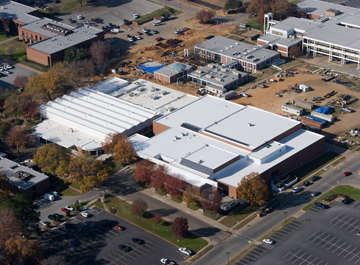The official colors of Tyler Junior College in Tyler, Texas, might be black and athletic gold, but when it comes to campus building roofs, the school prefers to see “white and green.” White, for the color of the Sika Sarnafil EnergySmart Roof® membrane, and “green” for the roof’s energy savings and environmental benefits.
“Tyler Junior College is one of the largest junior colleges in the nation, and our new college president, Dr. L. Michael Metke, wanted to make the campus ‘greener’ and shrink our ecological footprint,” explained Kevin Jones, assistant director of Facilities and Construction at Tyler Junior College. “So when we looked to replace some of the failing roofs at the college, we wanted to find a roofing system that was sustainable and good for the environment.”
Jones did some research on the Internet and found one product that would meet this criterion was the Sika Sarnafil roofing system. Unlike the dark-colored modified bitumen, ballasted EPDM, and BUR roofs previously installed on the college buildings, the EnergySmart Roof reflects 83% of the sun’s rays, thereby keeping the building cooler and reducing air conditioning costs. With an emissivity rating of 90%, the small amount of heat that is not reflected is quickly released back to the atmosphere.
“Our administration also liked the fact that the Sika Sarnafil roofing membranes can be recycled at the end of their useful lives,” Jones said. In fact, Sika Sarnafil recently became the first roofing manufacturer to receive UL recycled content certification.
Although Jones was impressed with the environmental benefits of the Sika Sarnafil membrane, he wanted to be sure that the roofing system would also perform well.
“I read that the Sika Sarnafil membrane was used on the new Dallas Cowboys stadium, so I contacted a Sika Sarnafil representative to learn more,” Jones said. “Not only did he give me a tour of the Cowboys stadium but he also showed me a 30-year-old Sika Sarnafil roof at a Southwest Foods warehouse and manufacturing facility here in Tyler — and that roof looked like it was only 10 years old. That’s when we decided to go with the Sika Sarnafil system.”
The Vaughn Library received the first Sika Sarnafil roof at the junior college in 2010, and the Wagstaff Gym was next. The school has been very pleased with their experience with Sika Sarnafil. Subsequently, Sarnafil® roofs were chosen for the campus Information Technology Building, the Genecov Science Building, and for the college’s Hudnall Planetarium.
“We wanted a roofing system that wouldn’t need any attention for a long time, and to date we have never had a single call or issue with any of the Sika Sarnafil roofs,” Jones said. “In fact, our goal is to install Sika Sarnafil roofing systems on all of our flat roofs.”
He added, “Sometimes following a green initiative is not economically feasible, but that’s not the case with the Sika Sarnafil roofs. They have a durable, long-lasting, energy efficient product backed up by a worldwide company.” BD+C
Related Stories
| Aug 19, 2011
Enhanced acoustical design
Ambient noise levels in some facility types are trending up and becoming a barrier to clear communication between building occupants.
| Jul 22, 2011
The Right Platform for IPD
Workstations for successful integrated project delivery, a white paper by Dell and BD+C.
| Jul 22, 2011
High-performance windows and doors
Learning objectives After reading this article, you should be able to: Understand issues of thermal performance and energy efficiency in relation to window and door systems; describe optimal detailing of the window-wall interface and how it contributes to building performance, sustainability, and occupant well-being; understand how durability contributes to sustainable windows/doors; and list sustainable O&M requirements for window and door systems.
| Jul 21, 2011
Falling Architecture Billings Index reflects decrease in design demands
This months Architecture Billings Index (ABI), provided by the American Institute of Architects, is almost a full point lower than last month’s reported score. June’s reading of 47.2 was short of the required 50 to achieve billings increases, making July’s reading of 46.3 an unwelcome sign of market tidings.
| Jun 29, 2011
New leadership role for architects in net-zero design
BD+C Editorial Director Rob Cassidy talks with RNL Design's Tom Hootman, AIA, about the changing role of architects in net-zero designs.














